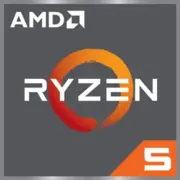AMD Ryzen 5 5600X3D

AMD Ryzen 5 5600X3D: A Gamer's Must-Have for the AM4 Platform
Overview of the processor with revolutionary 3D V-Cache and PC assembly tips
Key Features: Architecture, Process Technology, and Key Highlights
The AMD Ryzen 5 5600X3D is a special version of the popular Ryzen 5 5600X, enhanced with 3D V-Cache technology. The Zen 3 architecture (codename Vermeer) and 7nm process technology ensure high energy efficiency. The main feature is the massive L3 cache size (96 MB), which is three times larger than the base model (32 MB).
Performance:
- 6 cores / 12 threads;
- Base clock speed — 3.3 GHz, turbo mode up to 4.4 GHz;
- Geekbench 6 results: 2089 (single-core), 9119 (multi-core).
Key Highlights:
- 3D V-Cache — an additional layer of cache that speeds up data processing in games and applications with high memory access;
- Support for PCIe 4.0;
- Precision Boost 2 and AMD Eco Mode technologies for optimizing power consumption.
Practical example: In games like Cyberpunk 2077 or Microsoft Flight Simulator, the 5600X3D shows a 15-20% increase in FPS compared to the regular 5600X due to the cache.
Compatible Motherboards: Sockets and Chipsets
The processor uses the AM4 socket, making it compatible with most boards on B550, X570 chipsets, and even older B450/X470 (after a BIOS update).
Recommendations for Selection:
- B550 Chipset — optimal choice (e.g., MSI B550 Tomahawk or ASUS ROG Strix B550-F). Supports PCIe 4.0 and overclocking;
- X570 Chipset — for enthusiasts needing more PCIe lanes (e.g., Gigabyte X570 Aorus Elite);
- Important: Update the BIOS to the latest version before installing the processor. Some B450/X470 boards may require you to swap in an older CPU for the update (e.g., a Ryzen 3000).
Tip: Avoid cheap boards with weak VRMs (e.g., A320), as the 105W TDP can cause overheating.
Supported Memory Types: DDR4 vs DDR5
The Ryzen 5 5600X3D only works with DDR4 due to the limitations of the AM4 platform.
RAM Recommendations:
- Optimal frequencies: 3200–3600 MHz (e.g., Kingston Fury Renegade 3600 MHz);
- Timings: CL16 or lower to minimize latency;
- Capacity: 16 GB (2x8 GB) — minimum for gaming, 32 GB — for work tasks.
Important: Dual-Channel mode is mandatory! One DDR4-3600 stick will reduce performance by 10-15%.
Power Supplies: Power Calculation
With a TDP of 105W, the processor is power-hungry, especially when paired with a powerful graphics card.
Recommendations:
- Minimum: 550W (for systems with a GPU like the RTX 3060);
- Optimum: 650W (e.g., Corsair RM650x or Seasonic Focus GX-650);
- Essential: 80+ Bronze certification or higher.
Assembly Example: Ryzen 5 5600X3D + RTX 4070 will require a PSU of 650–750W.
Pros and Cons of the Ryzen 5 5600X3D
Pros:
- Best gaming processor in its class thanks to 3D V-Cache;
- Compatibility with AM4 — you can use old motherboards;
- Energy efficiency: 7nm process vs Intel's 10nm.
Cons:
- No support for DDR5 and PCIe 5.0;
- Only 6 cores — for heavy rendering, Ryzen 7/9 is better;
- High price (20-30% more expensive than the 5600X).
Usage Scenarios: Gaming, Work, Multimedia
- Gaming: Ideal for 1080p and 1440p. In CS2 or Valorant, it consistently delivers 300+ FPS;
- Work Tasks: Suitable for video editing in Premiere Pro or programming, but falls short compared to the Ryzen 7 5800X3D in multi-threaded tasks;
- Multimedia: Quick photo processing in Lightroom, but rendering 4K video will take longer than with 8-core CPUs.
Comparison with Competitors
- Intel Core i5-13400F: Cheaper but lags behind by 10-15% in gaming. Excels in multi-threaded tasks with its 10 cores;
- Ryzen 5 7600X: 15% faster in single-threaded tests but requires expensive DDR5 and AM5 platform;
- Ryzen 7 5800X3D: Best choice for those needing 8 cores, but 40% more expensive.
Practical Assembly Tips
1. Cooling: Use a cooler like the DeepCool AK620 or Arctic Liquid Freezer II 240. Temperatures under load can reach up to 75°C.
2. Case: Ensure good ventilation (at least 2 fans).
3. Memory: Activate XMP in BIOS to operate at the specified frequency.
4. Drivers: Install chipset drivers from AMD's website.
Final Conclusion: Who is the Ryzen 5 5600X3D for?
This processor is the ideal choice for:
- Gamers who want maximum FPS on the AM4 platform without switching to AM5;
- Owners of old systems with Ryzen 3000 looking for an upgrade;
- Enthusiasts who value technological innovations like 3D V-Cache.
Why this one? No other processor in its price segment offers such outstanding gaming performance thanks to its unique cache. If you’re not ready to invest in DDR5 and a new platform — the 5600X3D will be the best upgrade for AM4.
Basic
CPU Specifications
Memory Specifications
GPU Specifications
Miscellaneous
Benchmarks
Compared to Other CPU
Related CPU Comparisons
Share in social media
Or Link To Us
<a href="https://cputronic.com/cpu/amd-ryzen-5-5600x3d" target="_blank">AMD Ryzen 5 5600X3D</a>
